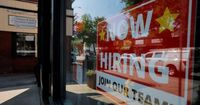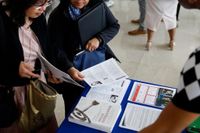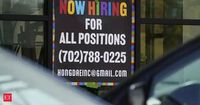For the week ending August 16, 2025, the number of Americans filing new applications for unemployment benefits jumped by 11,000 to 235,000, according to data released Thursday by the U.S. Department of Labor. This uptick, the largest increase since late May, has drawn attention from economists, policymakers, and market watchers alike, as it signals continued softness in the labor market and adds complexity to the Federal Reserve’s upcoming decisions on interest rates.
While the rise in jobless claims exceeded expectations—economists polled by Reuters and Bloomberg had forecast between 225,000 and 229,000 new applications—the figure still falls within what’s considered a historically healthy range. Since the U.S. began to emerge from the COVID-19 pandemic over three years ago, weekly applications for unemployment benefits have mostly hovered between 200,000 and 250,000, a range that reflects relative stability compared to the economic turmoil of early 2020.
Yet, as Reuters and Bloomberg both reported, the latest numbers mark the highest level of new claims since June, and the four-week moving average, which helps smooth out week-to-week volatility, also rose by 4,500 to 226,500. More tellingly, the total number of Americans collecting unemployment benefits for the week ending August 9 surged by 30,000 to 1.97 million—the highest tally since November 2021. This steady increase in continuing claims is widely viewed as a sign that laid-off workers are struggling to find new jobs, a trend that has become more pronounced in recent months.
“They’re one of the key signs we have a weakening job market,” said Andrew Stettner of The Century Foundation, as quoted by Marketplace. “More people staying on unemployment benefits than a year ago. Hiring really slowing down in all sectors except for health care.” Stettner added that while new layoffs have not reached recessionary levels, the inability of many to exit unemployment is causing the total number of benefit recipients to climb steadily.
Still, not everyone sees the glass as half empty. Amy Glaser, a senior executive at staffing firm Adecco, told Marketplace, “We don’t want to confuse weakness with moderation. We’re seeing a bit of a pause, not a halt, in hiring.” Glaser pointed to a combination of demographic trends—such as the retirement of baby boomers—and demand-side factors like tariffs and geopolitical uncertainty, which are contributing to a labor market in transition rather than outright decline.
Major corporations have also been making headlines with staff reductions in 2025. Companies such as Procter & Gamble, Dow, CNN, Starbucks, Southwest Airlines, Microsoft, Google, Meta (Facebook’s parent company), Intel, and The Walt Disney Co. have all announced layoffs or hiring freezes this year, as reported by The Associated Press and Barchart.com. These cuts reflect a broader hesitancy among employers to expand payrolls, a caution that many economists attribute in part to President Donald Trump’s protectionist trade policies. According to Reuters, these policies have pushed U.S. import duties to their highest level in a century, creating an environment of uncertainty that makes businesses more reluctant to hire.
The labor market’s recent performance has done little to assuage concerns. U.S. employers added only 73,000 jobs in July—well short of the 115,000 positions analysts had forecast. Even more troubling, revisions to the May and June job figures collectively erased 258,000 jobs from previous estimates, according to the Bureau of Labor Statistics (BLS). The unemployment rate edged up to 4.2% in July and is expected to tick higher to 4.3% in August, based on current trends. In Washington, D.C., the jobless rate has eclipsed 6% for the third straight month, the highest in the nation, a figure driven in part by mass layoffs of federal workers and a decline in international tourism, as noted by The Associated Press.
Federal workers have been particularly hard hit since the start of Trump’s second term. Across government agencies, employees have faced layoffs or have been asked to voluntarily resign, leading to lawsuits from labor unions and advocacy groups. Neighboring states Maryland and Virginia, where many federal employees reside, have also seen unemployment rates climb in July.
The broader economic picture remains mixed. On one hand, S&P Global’s flash U.S. Composite PMI Output Index, which surveys purchasing managers across manufacturing and services, rose to 55.4 in August, the highest since December. This suggests that business activity and hiring have picked up pace, particularly in the manufacturing sector, which posted its strongest new orders activity since February 2024. Chris Williamson, chief business economist for S&P Global Market Intelligence, noted, “A strong flash PMI reading for August adds to signs that U.S. businesses have enjoyed a strong third quarter so far.”
However, this apparent strength in business activity is at odds with the jobless claims data, which shows that hiring remains tepid and that job growth has averaged only 35,000 per month over the last three months. Domestic demand, meanwhile, grew in the second quarter at its slowest pace since late 2022, as reported by Reuters. The combination of slow job growth and rising unemployment claims has led some economists to predict further labor market deterioration, though not yet at the scale of a recession.
These developments come as the Federal Reserve prepares for its annual symposium in Jackson Hole, Wyoming, where Chair Jerome Powell and other central bank leaders are set to discuss "Labor Markets in Transition: Demographics, Productivity, and Macroeconomic Policy." The timing couldn’t be more relevant. As George Bory of Allspring Asset Management told Marketplace, “The demand for labor is contracting at a faster pace than the supply of labor. And you may see unemployment now start to move higher.”
The Fed faces a complicated balancing act. On the one hand, the softening labor market strengthens the argument for a rate cut at the central bank’s September meeting, a move that could provide some cushion for the job market. On the other hand, inflation remains stubbornly above the Fed’s 2% target, driven in part by the very tariffs that are weighing on hiring. As Reuters pointed out, this dynamic may make it difficult for the Fed to deliver the series of rate cuts investors are hoping for by year’s end.
Amid this uncertainty, there are glimmers of hope in other sectors. The National Association of Realtors reported that home sales rose 2% in July, buoyed by lower mortgage rates and a slight improvement in housing affordability. “The ever-so-slight improvement in housing affordability is inching up home sales,” said Lawrence Yun, the association’s chief economist. “Wage growth is now comfortably outpacing home price growth, and buyers have more choices.”
Still, the labor market remains at a crossroads. With the August payrolls report due September 5, policymakers and market participants alike will be watching closely—not just for the headline job growth number, but for any further revisions to previous months. As the U.S. economy navigates this period of transition, the stakes for workers, employers, and the broader economy have rarely felt higher.






